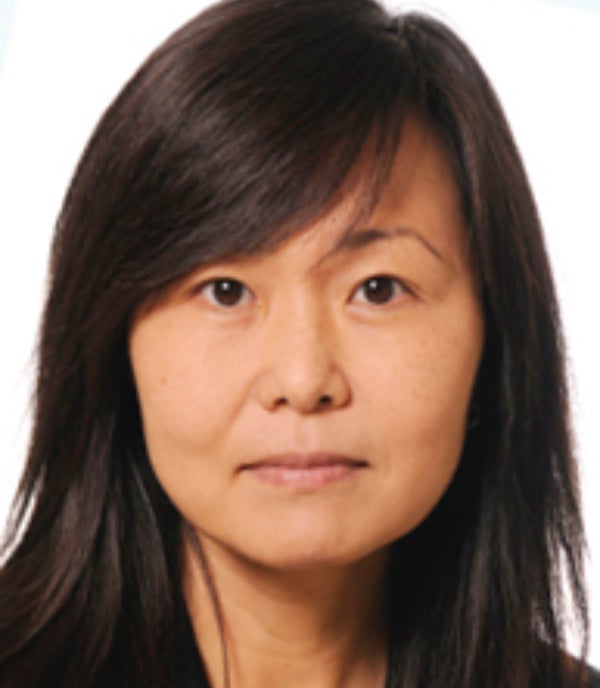Bridging biological and social sciences to address cancer disparities

Introduction Heading link
For years, the so-called African American Smoking Paradox has confounded researchers.
Despite lower prevalence and frequency of smoking – the culprit in some 90 percent of all lung cancer cases, according to American Lung Association data – Black Americans report higher lung cancer incidence and mortality rates than their white counterparts. It’s a puzzling mystery and a persistent racial disparity numerous well-intentioned researchers have attempted to unpack.
At the UIC School of Public Health, Sage Kim, PhD, associate professor of health policy and administration, is closing in on a potential explanation she hopes will inform new lung cancer screening protocols that improve early detection, foster improved patient outcomes and combat lingering health disparities.
“We’re at the cutting edge of social, biological and health sciences, and it’s an incredibly fascinating place to be,” Kim said.
Exploring environmental-biological connections Heading link

Aware of credible research detailing the role social stress plays in immune responses as well as various studies outlining ties between one’s zip code and personal health, Kim wondered if certain environmental factors might heighten lung cancer risk.
But first, she investigated biological factors that might be at play. She explored research linking chronic exposure to violence producing physiological stress responses and worked with colleagues who examined the Cyclooxygenase (COX)-2 enzyme, which promotes inflammation. Increased COX-2 expression, it turns out, frequently occurs in precursor legions of cancer. Kim also collaborated with a team of scientists who examined two protein arginine methyltransferases (PRMTs) – PRMT1 and PRMT6 – that are overexposed in lung cancer. PRMT6 is the only PRMT identified as showing racial difference.
“Greater exposure to social stress among Black Americans increases the inflammatory cell environment that is conducive to epigenetic changes related to lung cancer,” Kim explained.
An experienced data scientist, Kim then developed a data model exploring the relationship between communities with high violent crime and the probability of developing lung cancer. Looking at Chicago’s 77 community areas, she identified an interesting connection between neighborhood exposure to violence, predominantly Black communities on the city’s south and west sides, and the probability of developing lung cancer.
For those living in low-homicide areas of Chicago, the lung cancer rate for those 60 and older with a history of smoking was less than 13 percent. In communities with high homicide rates, however, the lung cancer rate stood seven points higher at 19.8 percent.
If one were to lay two color-coded maps of Chicago neighborhoods on a table, one featuring neighborhood lung cancer rates and a second identifying community homicide rates, they would look almost identical. Chicago neighborhoods with the highest homicide rates, such as Englewood on the south side and West Garfield Park on the city’s west side, also hold some of the city’s highest lung cancer rates.
By contrast, some of the lowest neighborhood
lung cancer rates sit in communities with lower homicide rates, such as Belmont Cragin on the northwest side and Garfield Ridge on the city’s southwestern edge. For Kim, the data offered compelling evidence that neighborhood factors, such as chronic exposure to local crime and violence, alter biological processes and affect individual health – in this case, lung cancer.
Pushing the research forward Heading link
A University of Illinois Cancer Center member, Kim is now working with a team of biologists and pathologists to study lung cancer specimens and investigate PRMT 6. In May, she also kicked off another stage of this National Institute on Minority Health and Health Disparities-funded project: recruiting Black men at Chicago barbershops to share hair samples and answer survey data. Together, these efforts will help Kim develop a deeper understanding of the connections between exposure to social stress and biophysical changes.
Whereas researchers once had limited ability to tie environment to biology, Kim said growing technical competencies continue helping investigators measure biological changes due to social stress.
“A decade ago, we couldn’t do something like this,” Kim said. “Now, we have the technical know-how and tools to look at social epigenetic changes and biomarkers we can actually measure.”
Ultimately, she hopes her research spurs changes to the current national lung cancer screening guidelines. At present, the U.S. Preventive Services Task Force recommends an annual lung cancer screening for adults over age 50 who have a 20-pack-year smoking history and currently smoke or have quit within the past 15 years. Those guidelines, Kim said, wholly ignore environmental factors.
“Smoking is not the only criteria that’s relevant here,” Kim said. “What about addressing neighborhood contextual factors?”
By shifting the national guidelines to account for a key environmental factor that may increase lung cancer risk, Black residents living in high-crime areas can be directed to earlier screenings. Kim said a context-specific lung cancer risk profile and systems-level interventions that may flag this relationship for healthcare providers can help improve early detection of lung cancer, particularly for Black lung cancer patients who tend to be younger and often do not fit existing lung cancer screening criteria.
“Right now, those who don’t meet the national screening guidelines simply go on with their lives and some of them end up with a late-stage diagnosis, which heightens the mortality rate,” Kim said. “Those are the cases we want to address and should feel compelled to address.”
Kim considers this transdisciplinary project an example of how the social sciences and health sciences can converge to propel healthier lives and greater health equity.
“While these two fields speak different languages, there is a shared aim to improve health outcomes and reduce health disparities,” Kim said. “Bringing these diverse fields together will advance science and, ultimately, population health.”